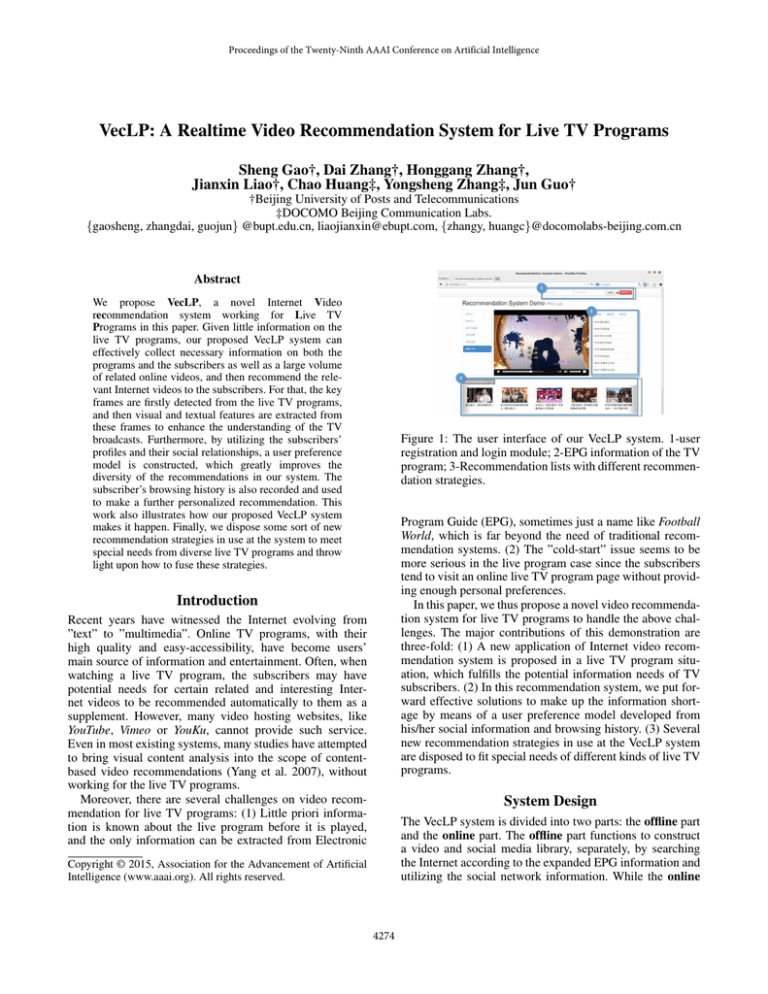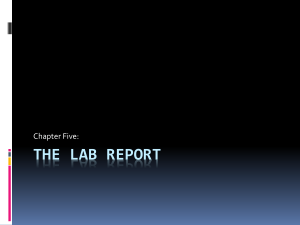
Proceedings of the Twenty-Ninth AAAI Conference on Artificial Intelligence
VecLP: A Realtime Video Recommendation System for Live TV Programs
Sheng Gao†, Dai Zhang†, Honggang Zhang†,
Jianxin Liao†, Chao Huang‡, Yongsheng Zhang‡, Jun Guo†
†Beijing University of Posts and Telecommunications
‡DOCOMO Beijing Communication Labs.
{gaosheng, zhangdai, guojun} @bupt.edu.cn, liaojianxin@ebupt.com, {zhangy, huangc}@docomolabs-beijing.com.cn
Abstract
We propose VecLP, a novel Internet Video
recommendation system working for Live TV
Programs in this paper. Given little information on the
live TV programs, our proposed VecLP system can
effectively collect necessary information on both the
programs and the subscribers as well as a large volume
of related online videos, and then recommend the relevant Internet videos to the subscribers. For that, the key
frames are firstly detected from the live TV programs,
and then visual and textual features are extracted from
these frames to enhance the understanding of the TV
broadcasts. Furthermore, by utilizing the subscribers’
profiles and their social relationships, a user preference
model is constructed, which greatly improves the
diversity of the recommendations in our system. The
subscriber’s browsing history is also recorded and used
to make a further personalized recommendation. This
work also illustrates how our proposed VecLP system
makes it happen. Finally, we dispose some sort of new
recommendation strategies in use at the system to meet
special needs from diverse live TV programs and throw
light upon how to fuse these strategies.
Figure 1: The user interface of our VecLP system. 1-user
registration and login module; 2-EPG information of the TV
program; 3-Recommendation lists with different recommendation strategies.
Program Guide (EPG), sometimes just a name like Football
World, which is far beyond the need of traditional recommendation systems. (2) The ”cold-start” issue seems to be
more serious in the live program case since the subscribers
tend to visit an online live TV program page without providing enough personal preferences.
In this paper, we thus propose a novel video recommendation system for live TV programs to handle the above challenges. The major contributions of this demonstration are
three-fold: (1) A new application of Internet video recommendation system is proposed in a live TV program situation, which fulfills the potential information needs of TV
subscribers. (2) In this recommendation system, we put forward effective solutions to make up the information shortage by means of a user preference model developed from
his/her social information and browsing history. (3) Several
new recommendation strategies in use at the VecLP system
are disposed to fit special needs of different kinds of live TV
programs.
Introduction
Recent years have witnessed the Internet evolving from
”text” to ”multimedia”. Online TV programs, with their
high quality and easy-accessibility, have become users’
main source of information and entertainment. Often, when
watching a live TV program, the subscribers may have
potential needs for certain related and interesting Internet videos to be recommended automatically to them as a
supplement. However, many video hosting websites, like
YouTube, Vimeo or YouKu, cannot provide such service.
Even in most existing systems, many studies have attempted
to bring visual content analysis into the scope of contentbased video recommendations (Yang et al. 2007), without
working for the live TV programs.
Moreover, there are several challenges on video recommendation for live TV programs: (1) Little priori information is known about the live program before it is played,
and the only information can be extracted from Electronic
System Design
The VecLP system is divided into two parts: the offline part
and the online part. The offline part functions to construct
a video and social media library, separately, by searching
the Internet according to the expanded EPG information and
utilizing the social network information. While the online
Copyright © 2015, Association for the Advancement of Artificial
Intelligence (www.aaai.org). All rights reserved.
4274
part tries to analyze the live TV programs to get more realtime video information to match with the candidate videos
in the library. All of this can be achieved by the following
four modules: the data crawler module, the live video analysis module, the user preference module and the personalized video recommendation module. Figure 2 illustrates an
overview of the VecLP system. The VecLP system takes the
live TV programs as main input, then the key frames are
extracted and analyzed, from which the textual and visual
information are generated as a representation for the current broadcast. Meanwhile, VecLP checks whether or not the
subscriber is a registered user and determines which recommendation strategies could be used, and then searches the
video library to make an output, which is a recommendation
list of relevant Internet videos for the current TV program.
Analyzing Live Program Video. The system autoextracts the key frames of the live TV program by the image
Color and Edge Directivity Descriptors (CEDD) and other
features. In addition, much valuable information is carried
out in other components, such as textual information, including the superimposed ones on the key frames and closed
captions. For example, in sports videos, we employ a method
combining face detection and jersey number recognition algorithms, to identify the players, which has vital influence
on video indexing. A combined and cooperative analysis of
these components would be far more effective in the realtime video processing and recommendation. In the next step,
we adapt the visual features combined with the caption and
the textual information extracted from the key frames to retrieve or recommend the Internet videos crawled and collected in the video library.
Modeling User Preference. We consider the user preference model as a combination of the long-term interests and
the short-term ones, in which long-term interests represent
users’ stable preferences and are extracted from users’ social network information, while the short-term preferences
are generated by users’ browsing histories. The social network information is collected by the data crawler module
from Sina Weibo and consists of the following content: (1)
semi-structured personal information, such as brief biography, personal labels, gender, age, location et al.; (2) microblogs the user has sent out; (3) social relationships (e.g.,
followers, followings etc). Work on this part is based on the
basic idea that the social relationship, especially the follow
relationship can be a good representation of the users’ interests. In addition, the browsing history, such as the video clips
that the user clicked or the score rated by the user, is also
recorded in our system to generate users’ short-term preferences.
Fusing Multimodal Strategies. After the steps above, the
VecLP system gets a relatively substantial information on
both the live programs and the users, and then the multimodal recommendation strategies can be respectively developed based on the following information: (A) the video
search results; (B) the user preference models; (C) the
users’ social relationships; (D) the users’ watching historical data as well as (E) the hot topics from social webcites.
In the VecLP demo system, the live TV programs are divided into 6 groups according to their types, which are news,
Figure 2: System design with two parts: the offline and online part.
movie, sport, interview, entertainment and advertising. Each
category owns its unique recommendation strategy. Moreover, all the strategies can generally be discriminated into
two categories according to whether the subscriber is a registered user or not. If an user visits the live program page
anonymously, VecLP only uses the combination of strategies
A and E due to the lack of user information. While for the
subscribers logging into the system, the system can easily
get users’ surrounding information and generate their preference models, and the strategies B, C and D can be added
to the fusion recommendations.
Illustration. Take a live TV play Love in the Spring
watched by a login subscriber as an example, our proposed
VecLP system may know little about the TV play except for
the title in advance. Through the query expansion, the system collects the related information like the actors: Shanshan Yuan or Haoming Yu in this play or style romantic
drama etc., as well as a large number of online videos about
these actors to construct the candidate library. Furthermore,
by analyzing the subscriber’s social network, the system
then generates her preference model to obtain her interest
in the actors or even the director, and gets a list of her ”closest” friends from her social networks. In the end, the system
uses several strategies to make a realtime personalized recommendation for her when watching this TV play.
Based on the diverse recommendation strategies, our proposed VecLP system can effectively and efficiently provide
realtime personalized recommendation for the subscribers
with various needs in task of watching live TV programs.
Acknowledgments
This research was supported by the NSF of China under grant No.
61300080, No. 61273217, the Research Funds for the Central Universities No. 2013RC0119, the 111 program of Advanced Intelligence and Network Service No. B08004. The authors are partially
supported by the Key Project of Chinese Ministry of Education No.
MCM20130310 and DOCOMO Beijing Labs.
References
Yang, B.; Mei, T.; Hua, X.-S.; Yang, L.; Yang, S.-Q.; and Li, M.
2007. Online video recommendation based on multimodal fusion
and relevance feedback. CIVR ’07, 73–80.
4275


